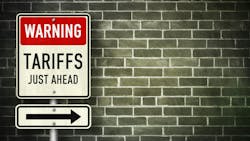How can manufacturing survive and thrive in the tariff era?
What you’ll learn:
- The current PMI numbers reflect a manufacturing sector caught between weak domestic momentum and international turbulence.
- For manufacturers and retailers alike, the question is how to respond when tariffs can change the economics of an entire category overnight.
- With tariffs distorting economics across categories, companies have elevated “tariff engineering” from a niche tactic to a survival skill.
The latest ISM Manufacturing PMI shows the sector still in contraction, with business leaders citing tariffs as a key driver of surcharges, delays, and planning uncertainty. Far from background noise, tariffs have become a structural force reshaping supply chains and determining which companies can compete.
The current PMI numbers reflect a manufacturing sector caught between weak domestic momentum and international turbulence. Tariffs are a permanent variable in the equation of global trade. Yet disruption also breeds opportunity.
See also: Survey: Manufacturers mostly see competitive advantage of AI, but adoption is uneven
This environment underscores a central truth: For manufacturers and retailers alike, the question is how to respond when tariffs can change the economics of an entire category overnight. Demand signals suggest cautious optimism, but the infrastructure of supply (where to source, how to price, and how to ensure availability) remains unsettled.
Regional hubs can replace global supply chains
For decades, the logic of global supply chains was simple: Build where labor was cheap, ship across oceans, and rely on stable trade regimes to keep costs predictable. That model is eroding—rapidly. Rising tariffs, profound political divisions, and shifting cost structures have fractured the single global backbone into regional ecosystems.
Mexico and Canada are increasingly extensions of U.S. supply, while Vietnam and Southeast Asia offer alternatives to China. In Europe, Eastern Europe and Poland are expanding their roles in manufacturing and logistics. This fragmentation in supply chains is about two things: cost and resilience. Regional ecosystems shorten lead times, reduce tariff exposure, and bring companies closer to end markets.
See also: Webinar replay: As tariff war whipsaws world economy, ‘uncertainty is the new certainty'
The implication is clear: the companies best positioned for tomorrow will be those that can flex sourcing across regions rather than tying themselves too tightly to a single global model.
Tariff engineering as survival
With tariffs distorting economics across categories, companies have elevated “tariff engineering” from a niche tactic to a survival skill. This includes adjusting product form, reformulating components, or shifting final assembly to qualify under different tariff codes.
A sneaker redesigned with a removable back can be classified as a slipper. A T-shirt with a pocket can be classified as a nurse’s uniform. These changes may seem trivial, but they can preserve millions in margin impact.
See also: Ready to reshore? Surveys show hurdles to returning more manufacturing to U.S.
This kind of engineering extends beyond classification. Some companies invest in finishing steps in tariff-friendly regions to change the “country of origin” and reduce duties. Others restructure supply contracts or pursue acquisitions in low-tariff markets to build alternate sourcing paths. Flexibility has become just as valuable as efficiency.
Private labels as a cushion
Private label products are goods made by manufacturers but sold under a retailer’s brand, giving retailers end-to-end control over formulation, sourcing, and pricing. For these products, retailers, not manufacturers, are the primary drivers of tariff engineering, a strategy essential for maintaining competitiveness.
By directing manufacturers to reformulate recipes, shift final assembly, or adjust packaging, retailers can reduce their tariff exposure while still meeting consumer demand. These behind-the-scenes adjustments help stabilize the retailer's programs and protect their margins, keeping private label products competitive even in volatile trade conditions.
Stockpiling and scenario planning
The ISM report notes that inventories may now be “too low”—a warning sign for potential shortages. But stockpiling is a double-edged sword. Building inventory ahead of tariff hikes can protect availability, yet overbuying risks costly carrying costs if demand cools.
Webinar replay: Made in America, Powered by Tech: Is U.S. Manufacturing Ready to Scale?
Here is where scenario planning becomes a strategic advantage, especially in the age of AI, which includes specialized AI like machine learning algorithms, generative AI and now agentic AI.
By running simulations, AI helps companies quickly see cost impacts, find alternative suppliers, or adjust product designs to lower duties. Combined with forecasting and inventory planning, AI ensures businesses keep shelves stocked and prices steadier, even when trade rules shift.
On-shelf availability: The real KPI
All these strategies ultimately serve one purpose: keeping shelves stocked at reasonable prices. Consumers don’t measure supply chain success by freight rates or tariff codes; they measure it by whether the product they want is available on-shelf or online at a reasonable price.
For businesses, that availability is increasingly a cross-functional challenge that links sourcing, inventory, pricing, and promotion. Failures in one area quickly cascade into another. For example, tariffs may drive up input costs, but if those costs are not managed through sourcing adjustments or private-label shifts or product reformulations.
See also: IT-OT convergence as a driver for manufacturing innovation
If stockpiling is mistimed, shelves run bare, eroding consumer trust. Companies that make on-shelf availability their north star are better able to balance cost pressures with customer expectations.
Companies that rely solely on efficiency—maximizing low-cost sourcing from a single region, assuming tariffs will stay constant—are increasingly vulnerable. Those that build agility into their planning, test scenarios, and rebalance sourcing across regions will turn volatility into competitive advantage.
In this sense, the tariff environment is less a policy debate than a wake-up call. The global supply chain model that delivered predictability for decades is gone. A new geography is emerging, one defined by regional hubs, smarter planning, and relentless focus on keeping shelves stocked.
The PMI reading is a signal that strategy must shift from reacting to tariffs toward mastering them. Those who adapt will be remembered for showing up when it mattered most.
About the Author

Rohit Tripathi
Rohit Tripathi is VP of industry strategy for manufacturing at RELEX, which specializes in supply chain and business operations, including their AI-led digital transformations. He has more than 25 years of experience managing global teams in the U.S., India, Brazil, and Europe, delivering AI-enabled products and solutions for supply chain, IoT, customer experience, and supply chain resiliency.
